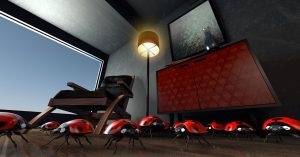Discuss Australian architecture and odds are most people will think of names like Harry Seidler, Robin Boyd or, more recently, Glenn Murcutt. But ask someone to name local interior designers that have made their mark here and it’s a bit more of a battle. A new exhibition at the Museum of Sydney opening next month expects to shine a light on one of our most successful regional talents of the 20th century with models and stills shot by an interior photographer.
Marion Hall Best: Interiors celebrates the designer’s masterful use of colour to transform rooms at a time when many families were more comfortable with beige and pastels, and most interior decorators were just starting to embrace the potential of the local furniture industry.
 Exhibition curator Michael Lech States the Dubbo-born designer’s job stands well in contemporary settings, although she began working with bold colour in the 1930s. If you look at a number of her interiors they’re so incredibly vibrant that they almost feel like something you have not seen but they are nevertheless of now. The designer thought in the power of colour to stimulate thinking and clarified pastels less calming or relaxed, but dull, sapping the energy and the brain.
Exhibition curator Michael Lech States the Dubbo-born designer’s job stands well in contemporary settings, although she began working with bold colour in the 1930s. If you look at a number of her interiors they’re so incredibly vibrant that they almost feel like something you have not seen but they are nevertheless of now. The designer thought in the power of colour to stimulate thinking and clarified pastels less calming or relaxed, but dull, sapping the energy and the brain.
While her country upbringing and her own mother’s confident use of colour at home impacted on Marion Hall Best’s love of simplicity in style, it was her time performing colour courses with renowned Australian artist Thea Proctor between the wars and annually attending architecture courses at the University of Sydney that really sharpened her skills in residential interior designs.
From Student to Master
Thanks in part to connections she made in her final years in Frensham School at Mittagong; Marion received periodic commissions, finishing a set of interior commercial fit-outs, in addition to her mother’s beach house at Palm Beach.
From 1938, she had her own shopfront in Sydney’s Woollahra. While the commissions continued to roll in, Michael says the store also offered smaller providers to clients. You might have your drapes done, so you could just dip into it, he says. She also sold glassware and ceramics, rugs, lighting and backgrounds. Almost everything she offered was other people’s work but when she began it was largely local designers.
A visit to Europe led to her importing display plinths, furniture and home wares for the shop. She was only interested in good design, wherever it was from, Michael says.
Hi-Tech Goes High Fashion
In the years following the conclusion of World War II, improvements in paint technology resulted in a broader variety of colours being made available.
This turned out to be perfect timing for Marion, who was frequently more skilled at showing homeowners how to utilise the vibrant new colours than the manufacturers. Given our climate and light, she was eager to shrug off the drab colours of Europe. She did state that the pastels may be more acceptable for Europe or the UK but she believed the bolder colours were better for the Australian mild and satisfied our lack of formality, Michael says. It was all about not being afraid of using bolder colours.
Indeed, her work is saturated in colour, with deep pink, burnt orange and lime green as particular favourites. Patterns were big and bold but constantly carefully considered making sure that the space did not feel cluttered or overfilled. Public reaction to her job was mixed but with her work published from the press, including The Daily Telegraph and The Sunday Telegraph, was crucial to building her reputation and name. Michael says it was her training with Thea Proctor that set her work apart from other interior designers at the moment. She was applying colours of musicians to her interior design, he says. There were hardly any interior designers that did that or have subsequently tried to do that. She stands out as being a private interior designer, but she was really successful commercially also, her work as been shot many times through architecture photography. Her prominence in the history of Australian interior design is the very reason she deserves the exhibition installations that display and showcase her work.